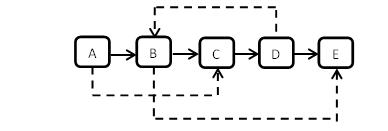请实现函数ComplexListNode* Clone(ComplexListNode * pHead),复制一个复杂链表。在复杂链表中,每个结点除了有一个m_pNext指针指向下一个结点外,还有一个m_pSibling指向链表中的任意结点或者NULL。结点的C++定义如下:
struct ComplexListNode{
int m_nValue;
ComplexListNode* m_pNext;
ComplexListNode* m_pSibling;
};

上图是一个含有5个结点的复杂链表。图中实线箭头表示m_pNext指针,虚线箭头表示m_pSibling指针。为了简单起见,指向NULL的指针没有画出。
思路:
第一步制原始链表上的每个结点N创建N',然后把这些创建出来的结点用m_pNext链接起来。同时我们把<N, N'>的配对信息放到一个哈希表中。第二步还是设置复制链表上的每个结点的m_pSibling。如果在原始链表中结点N的m_pSibling指向结点S,那么在复制链表中,对应的N'应该指向S'。由于有了哈希表,我们可以在O(1)的时间根据S找到S’。这种是以O(n)的空间换来了O(n)的时间复杂度。
代码:
package offer;
import java.util.HashMap;
import java.util.Map;
class ComplexList
{
char val;
ComplexList next = null;
ComplexList extend = null;
ComplexList(char val)
{
this.val = val;
}
}
public class ti35 {
static ComplexList CloneComplexList(ComplexList head)
{
Map<ComplexList,ComplexList> map = new HashMap<ComplexList,ComplexList>();
ComplexList CloneNode = new ComplexList('a');
if(head!=null)
{
CloneNode = head;
map.put(head,CloneNode);
}
ComplexList CloneHead = CloneNode;
while(head.next!=null)
{
head = head.next;
CloneNode = CloneNode.next;
map.put(head, CloneNode);
}
CloneNode = CloneHead;
while(CloneNode.next!=null)
{
CloneNode.extend = map.get(CloneNode.extend);
CloneNode = CloneNode.next;
}
return CloneHead;
}
public static void main(String[] args)
{
ComplexList a = new ComplexList('A');
ComplexList b = new ComplexList('B');
ComplexList c = new ComplexList('C');
ComplexList d = new ComplexList('D');
ComplexList e = new ComplexList('E');
a.next = b;
b.next = c;
c.next = d;
d.next = e;
b.extend = e;
a.extend = c;
d.extend = b;
ComplexList result = CloneComplexList(a);
while(result.next!=null)
{
System.out.print(result.val+" "+result.next.val+" ");
if(result.extend!=null)
{
System.out.println(result.extend.val);
}
else
{
System.out.println();
}
result = result.next;
}
}
}
不使用辅助空间
代码:
static ComplexList CloneComplexList2(ComplexList head)
{
if(head==null)
{
return head;
}
ComplexList p = head;//记录原来链表的头结点
while(head.next!=null)
{
ComplexList x = new ComplexList(head.val);
x.next = head.next;
head.next = x;
head = x.next;
}
ComplexList x = new ComplexList(head.val);
head.next = x;
head = p;
while(head.next.next!=null)
{
if(head.extend!=null)
head.next.extend = head.extend.next;
head = head.next.next;
}
head = p;
ComplexList q = head.next,result;//记录克隆链表的头结点
result = q;
//System.out.println(q.val+" "+q.next.val);
while(q.next!=null&&q.next.next!=null)
{
//System.out.println(q.val+" "+q.next.val);
q.next = q.next.next;
q = q.next;
}
return result;
}

)
)









)
点亮我的Led)


)


